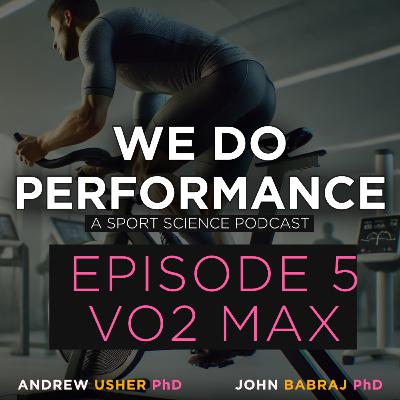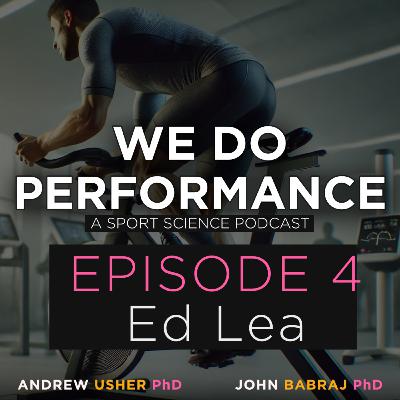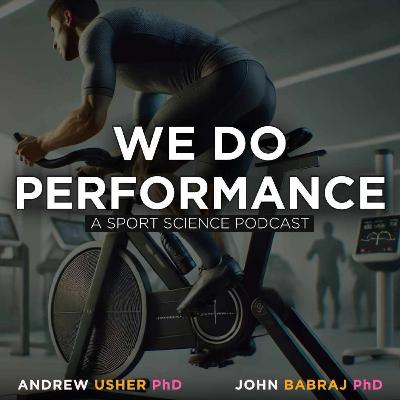Discover We Do Performance - A Sport Science Podcast
We Do Performance - A Sport Science Podcast

We Do Performance - A Sport Science Podcast
Author: andrew-usher
Subscribed: 1Played: 7Subscribe
Share
© andrew-usher
Description
Join Dr Andrew Usher and Dr John Babraj as they dive into research reviews, sports science concepts, chat with featured guests, and introduce you to the exciting world of high performance and sports science.
5 Episodes
Reverse
summaryIn this episode of the We Do Performance podcast, John and Andrew delve into the intricacies of VO2, VO2 Max, and MVO2, exploring their significance in sports performance. They discuss the testing methods, the importance of proper execution, and the nuances of interpreting results. The conversation also highlights the growing popularity of VO2 Max testing, the role of muscle oxygen utilization, and the critical aspect of recovery in athletic training. Ultimately, they question the relevance and value of VO2 Max testing for athletes, emphasising the need for a deeper understanding of physiological principles.takeawaysVO2 max is the maximal amount of oxygen consumed during intense exercise.The accuracy of VO2 max testing can vary significantly based on equipment and operator skill.Many athletes do not fully understand the implications of their VO2 max scores.Incremental treadmill tests can provide useful insights into an athlete's fitness level.MVO2 testing offers a new perspective on muscle oxygen utilization during exercise.Recovery is a crucial component of athletic performance and should be prioritized in training.VO2 max scores may not be the best indicator of performance for all athletes.The popularity of VO2 max testing has led to a proliferation of testing facilities, but quality varies.Understanding the nuances of testing can lead to better training outcomes for athletes.Athletes should focus on performance metrics that directly relate to their sport rather than solely on VO2 max scores.
In this episode of the We Do Performance podcast, Ed Lee, a seasoned performance coach at Harlequins, shares his journey in rugby and the evolution of strength and conditioning practices. He discusses the importance of individualized training, the role of acceleration in athlete performance, and the psychological benefits of sprint training. Ed emphasizes the need for freshness over fitness in training schedules and how sprinting can serve as both a training tool and a screening method for athletes. The conversation highlights the challenges and realities of training elite athletes and the continuous adaptation required in coaching methods. In this conversation, Ed and the team delve into the complexities of physiological limiters in athletic performance, focusing on the distinctions between central and peripheral limitations. They explore the use of Near-Infrared Spectroscopy (NIRS) as a tool for understanding muscle function and performance metrics. The discussion highlights the importance of data-driven insights in training, particularly in rugby, where conditioning strategies must adapt to the demands of the sport. The conversation also touches on the significance of scrum and mauling in conditioning, the art of pushing athletic limits, and the need for a comprehensive understanding of conditioning to enhance overall performance.Keywordsrugby, performance coaching, strength and conditioning, athlete training, acceleration training, sports science, team sports, training adaptation, psychological benefits, individualized training, physiological limiters, central limitations, peripheral limitations, NIRS, athletic training, performance improvement, scrum conditioning, mauling, data-driven insights, conditioning strategies
In this episode Andrew is joined by Strength and Conditioning and Performance coach Bill Smart. Bill has worked in numerous sports, from BMX, Cycling to MMA, and has been responsible for the strength and conditioning of UFC athletes such as Israel Adesanya.In this chat, we discuss everything from how to elicit the energy system demands of sport, to the use of Train Red NIRS to profile athletes and much more.Chapters00:00 Introduction to Bill Smart and His Background03:13 The Evolution of Strength and Conditioning in Combat Sports06:02 The Unique Attributes of BMX Athletes09:02 Training Methodologies for Elite Athletes11:58 The Importance of Needs Analysis in Performance Training14:56 The Role of Experience in Strength and Conditioning17:55 Insights from Personal Combat Sports Experience20:49 The Intersection of Skill and Strength in Combat Sports23:25 Conditioning Strategies for Boxing and Combat Sports25:58 The Role of Elasticity and Power Generation in Fighting29:14 Conclusion and Future Directions in Strength and Conditioning33:28 Elasticity and Shock Absorption in Combat Sports36:46 Understanding Fatigue and Recovery in Athletes38:48 The Role of Psychology in Performance40:30 Mental Toughness and Pressure Testing43:19 Identifying and Addressing Performance Issues49:13 The Importance of Observations in Competition53:53 Utilizing NIRS Technology in Training01:02:42 Exploring Athletic Profiles and Training Differences01:04:42 Understanding Muscle Oxygenation and Endurance01:06:35 Hypertrophy's Impact on Athletic Performance01:08:35 The Role of Training Methods in Energy Systems01:10:30 Striking Techniques and Force Measurement01:23:43 Concluding Thoughts on Performance and Research
In this episode John and I discuss NIRS ( Near Infra-Red Spectroscopy ) and how to use them to measure muscle oxygenation. We dive into the pro's an con's of a couple of brands, and tips on how to set them up, where to place them and some best practices on how to use them.For those interested in acquiring a Train Red sensor, the my affiliate code will give you 10 percent off.train.red/THEANDREWUSHER Or simply use the code THEANDREWUSHER and the checkout.
Join Dr John Babraj and Dr Andrew Usher as they dive into the world of high performance and sport science. In this episode they delve into mitochondria, along with Sprint Interval Training, their research into mitochondrial adaptations, NIRS and what ramifications mitochondrial adaptations have for sport and exercise.







